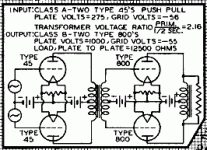The 6HB6's aren't even shaking in their tube sockets. I have yet to see one of them glow red.
I found the high power formula with some old Baldwin branded Sylvania 6BQ5's that I pulled out of a discarded church organ amp. It had 8 tubes, 7 Baldwins from the 1960's and 1 Radio Shack from the 80's. Guess which one was bad. Nice old amp. 50+ years old, but only used on Sundays.
I put a SPP amp on a bench power supply an started turning knobs, I was surprised to see over 30 watts from these old tubes. Most of the old 6BQ5's that I tried had no problem running at this level. The only new production EL84 that handles this is JJ. All the 6HB6's that I tried (about a dozen) had no problem at 30 watts.
I found the high power formula with some old Baldwin branded Sylvania 6BQ5's that I pulled out of a discarded church organ amp. It had 8 tubes, 7 Baldwins from the 1960's and 1 Radio Shack from the 80's. Guess which one was bad. Nice old amp. 50+ years old, but only used on Sundays.
I put a SPP amp on a bench power supply an started turning knobs, I was surprised to see over 30 watts from these old tubes. Most of the old 6BQ5's that I tried had no problem running at this level. The only new production EL84 that handles this is JJ. All the 6HB6's that I tried (about a dozen) had no problem at 30 watts.
I am inclined to think that the B+ could be run about 50 to 80 Volts, and still be reasonably safe. Providing one limits current capability of that particular supply. Voltage is not necessarily the only danger, so in designing for a 1/4 watt or 1/2 watt the B+ could be derived from a charge pump of low power, for example. The DC feed to the charge pump could be variable regulator so it could multiply in that range to get variable B+ ? Making sure that the VA of the plate supply is limited
>> supplying the screens of the preamp tubes .... I could just connect the screens to the supply. Makes for a lower parts count and complexity.
> Interesting screens connections - never thought of that.
The happy-voltage for most all-purpose pentodes' screens is 20V to 100V.
When you only have 45V, the decision is pretty clear.
For a LOW level stage, dropping Vg2 to 20V gives slightly more gain. But less output. Even the first stage of a guitar amp is liable to overload, get "a little ratty".
> low voltage supply requires lower impedance range seen by the power tubes?
For "best match", no. Current goes down faster than voltage, so lower voltage leads to higher optimum load impedance. Not so you notice from 300V to 250V. But from 110V to 45V, enough to consider. OTOH such low-volt designs are inevitably low-low-power, which better be what you want. Then "optimum load power" might NOT be the main goal. Indeed wrong-loading so you can distort bad without annoying neighbors may be the way to go.
> None of these will make much power on low voltage without positive grid voltage.
_IF_ that was a goal, and positive-grid not a deterrent (but that's not the typical rock-guitar style), then a low-cost 6J6 may be inneresting. Has pos-grid ratings. I remember figuring a number near 1 Watt P-P with under 100V supply. Since 6J6 was used in HUGE numbers, there may still be some (or kin) out there? However you need a steep step-down transformer (or a couple 2N3055) to pass the grid current of a massive-parallel 6J6 amp.
> Interesting screens connections - never thought of that.
The happy-voltage for most all-purpose pentodes' screens is 20V to 100V.
When you only have 45V, the decision is pretty clear.
For a LOW level stage, dropping Vg2 to 20V gives slightly more gain. But less output. Even the first stage of a guitar amp is liable to overload, get "a little ratty".
> low voltage supply requires lower impedance range seen by the power tubes?
For "best match", no. Current goes down faster than voltage, so lower voltage leads to higher optimum load impedance. Not so you notice from 300V to 250V. But from 110V to 45V, enough to consider. OTOH such low-volt designs are inevitably low-low-power, which better be what you want. Then "optimum load power" might NOT be the main goal. Indeed wrong-loading so you can distort bad without annoying neighbors may be the way to go.
> None of these will make much power on low voltage without positive grid voltage.
_IF_ that was a goal, and positive-grid not a deterrent (but that's not the typical rock-guitar style), then a low-cost 6J6 may be inneresting. Has pos-grid ratings. I remember figuring a number near 1 Watt P-P with under 100V supply. Since 6J6 was used in HUGE numbers, there may still be some (or kin) out there? However you need a steep step-down transformer (or a couple 2N3055) to pass the grid current of a massive-parallel 6J6 amp.
Wow, really nice... looks just like a weekend project scratch! I do not have a lot of experience with tube amps because I started to learn about tube amps 7-9 months ago... It started with... How does my dad's Fender work... shortly after this I was hooked to tube electronics and stuff...
- Status
- This old topic is closed. If you want to reopen this topic, contact a moderator using the "Report Post" button.
- Home
- Live Sound
- Instruments and Amps
- Low voltage Marshall inspired amp for voltage challenged individuals.
